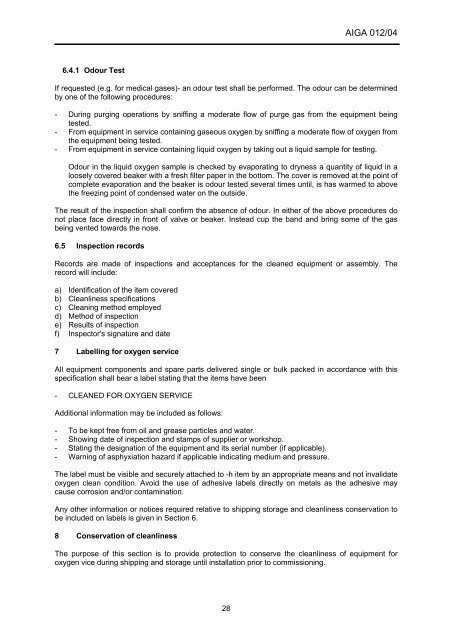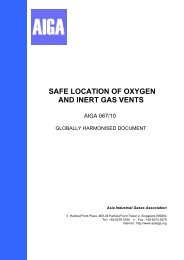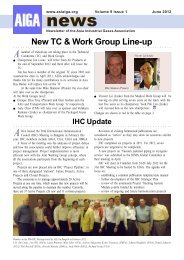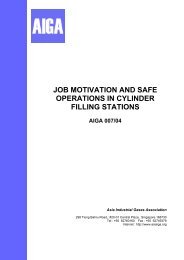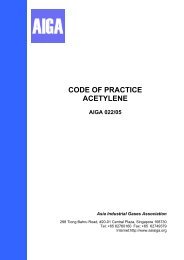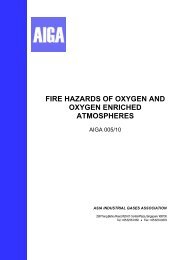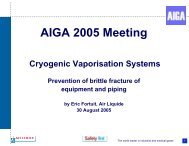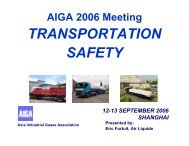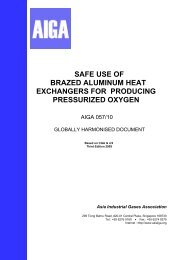CLEANING OF EQUIPMENT FOR OXYGEN SERVICE - AIGA
CLEANING OF EQUIPMENT FOR OXYGEN SERVICE - AIGA
CLEANING OF EQUIPMENT FOR OXYGEN SERVICE - AIGA
Create successful ePaper yourself
Turn your PDF publications into a flip-book with our unique Google optimized e-Paper software.
6.4.1 Odour Test<br />
28<br />
<strong>AIGA</strong> 012/04<br />
If requested (e.g. for medical gases)- an odour test shall be performed. The odour can be determined<br />
by one of the following procedures:<br />
- During purging operations by sniffing a moderate flow of purge gas from the equipment being<br />
tested.<br />
- From equipment in service containing gaseous oxygen by sniffing a moderate flow of oxygen from<br />
the equipment being tested.<br />
- From equipment in service containing liquid oxygen by taking out a liquid sample for testing.<br />
Odour in the liquid oxygen sample is checked by evaporating to dryness a quantity of liquid in a<br />
loosely covered beaker with a fresh filter paper in the bottom. The cover is removed at the point of<br />
complete evaporation and the beaker is odour tested several times until, is has warmed to above<br />
the freezing point of condensed water on the outside.<br />
The result of the inspection shall confirm the absence of odour. In either of the above procedures do<br />
not place face directly in front of valve or beaker. Instead cup the band and bring some of the gas<br />
being vented towards the nose.<br />
6.5 Inspection records<br />
Records are made of inspections and acceptances for the cleaned equipment or assembly. The<br />
record will include:<br />
a) Identification of the item covered<br />
b) Cleanliness specifications<br />
c) Cleaning method employed<br />
d) Method of inspection<br />
e) Results of inspection<br />
f) Inspector's signature and date<br />
7 Labelling for oxygen service<br />
All equipment components and spare parts delivered single or bulk packed in accordance with this<br />
specification shall bear a label stating that the items have been<br />
- CLEANED <strong>FOR</strong> <strong>OXYGEN</strong> <strong>SERVICE</strong><br />
Additional information may be included as follows:<br />
- To be kept free from oil and grease particles and water.<br />
- Showing date of inspection and stamps of supplier or workshop.<br />
- Stating the designation of the equipment and its serial number (if applicable).<br />
- Warning of asphyxiation hazard if applicable indicating medium and pressure.<br />
The label must be visible and securely attached to -h item by an appropriate means and not invalidate<br />
oxygen clean condition. Avoid the use of adhesive labels directly on metals as the adhesive may<br />
cause corrosion and/or contamination.<br />
Any other information or notices required relative to shipping storage and cleanliness conservation to<br />
be included on labels is given in Section 6.<br />
8 Conservation of cleanliness<br />
The purpose of this section is to provide protection to conserve the cleanliness of equipment for<br />
oxygen vice during shipping and storage until installation prior to commissioning.


